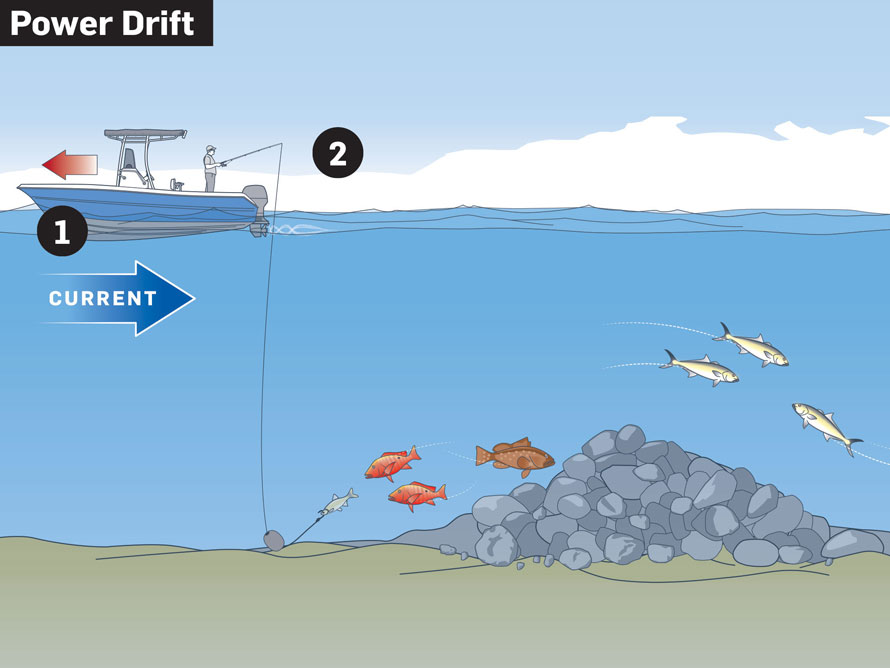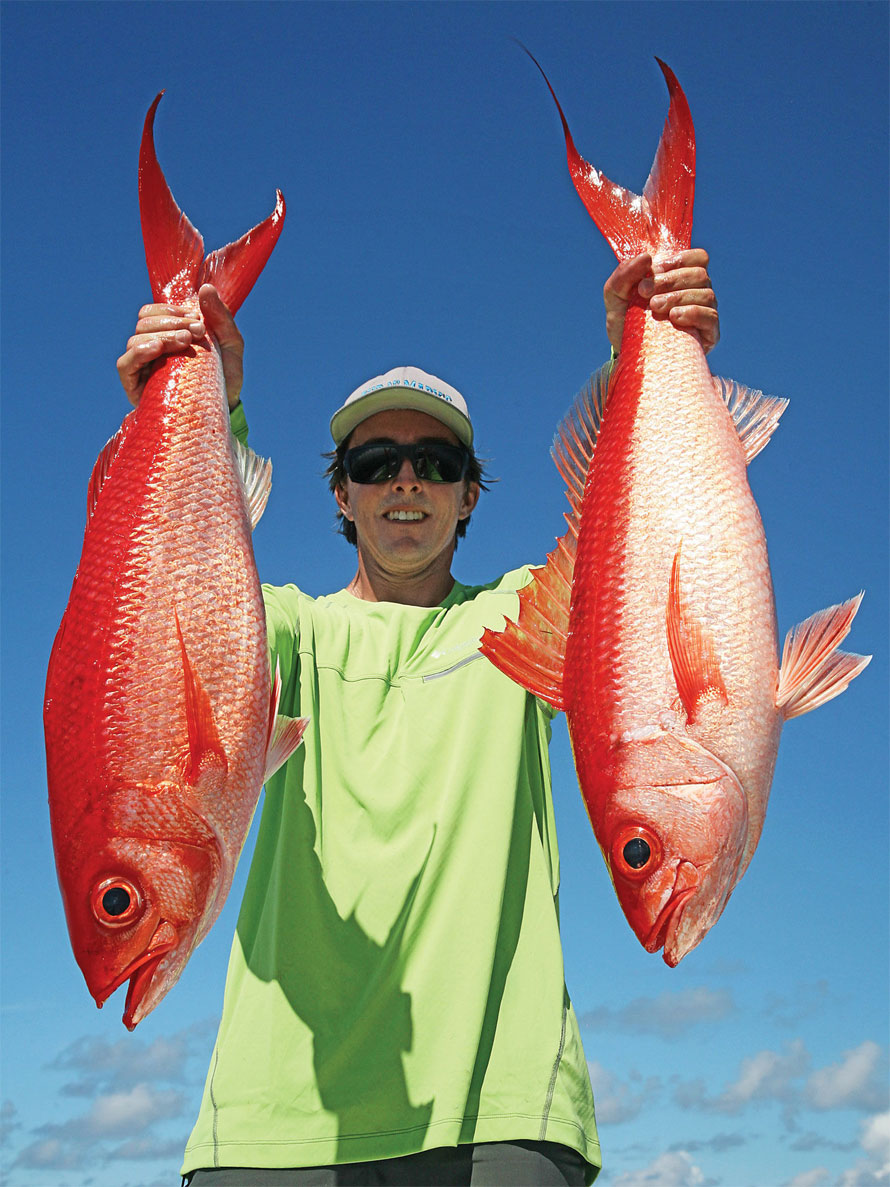Celebrating
|
How To Catch Bottom Fish
|
| Increase Your Catches With Precision Bottomfishing Techniques |
| by George Poveromo |
 |
| Proof Deep dwellers such as barrelfish demand honed strategies. If your bait isn’t where the fish lurk, don’t expect to catch them. A pitfall of drifting for bottomfish, or even striped bass, snook or tarpon nestled deep in a trough, inlet or channel, is that a brisk current or breeze can increase drift speed and, in turn, sweep baits well above the strike zone. To reach deep-holding fish under such conditions, additional weight is a common adjustment, but often a handicap. Increasing weight may be unavoidable, but going too heavy hinders bait presentation, alerts fish picking up the bait, inhibits the detection of subtle bites and sensitivity to the bottom, and possibly impedes the fight, making it difficult to keep tight to a fish or easier for one to shake free courtesy of a heavy sinker on the line. The tactics outlined below will keep a bait soaking along the bottom without excessive weight during full or controlled drifts. Put these into play and you’ll become a master at pulling up fish from the deep. Free-spool and Hold Drifting remains popular for catching bottomfish over hard ocean floor. The bait rides along the bottom as the drifting boat covers ground. With a light current, the bait remains near bottom and around fish. However, a freshening wind or current increases speed and planes the lines upward, above the fish, making a simple drift problematic. To counteract bait lift, free-spool and reconnect with the bottom. Then, rather than engaging the drag, leave the reel in free-spool and feather the line to feel the weight on the bottom. Line will pay out as the boat drifts, immune to planing. The bait gets maximum soak time, providing ample opportunity for fish to home in on the panicked vibrations of a livey or the scent of a natural bait. Once a hundred yards or so of line are out (exact distance based on depth and situation), reel in, replace the bait if necessary, drop back down and repeat the tactic. |
 |
| Free-spool and Hold 1. Drop the bait directly below the boat in the target zone as you pass it. 2. Pay out line slowly as the boat drifts, keeping the bait in place. Any strike will be detected by the sudden acceleration of line leaving the reel. Simply engage the drag, wind until the rod bends and hooks the fish, and enjoy the fight. A conventional reel, adequately weighted and fished from a gunwale holder in free-spool with a clicker activated, provides audible monitoring as the boat drifts along to assure the bait is on the bottom, and it provides a sudden screaming when a fish hits. At this point, you need only engage the drag to set the hook. The free-spool-and-hold tactic continues to reward me with all types of bottomfish. This past season, for example, Nick Stanczyk and I employed this technique in 680 feet of water off Islamorada in the Florida Keys to catch big queen snapper and barrelfish. Down-current Pitch In shallow-water situations, and around bridges, within inlets, passes and channels, and over scattered bottom structure and wrecks, try casting down-current or downwind to control the drift, letting the bait settle as the boat catches up to it. Unlike free spooling, pitching down-current eliminates most resistance on a rig. Therefore, even less weight may be required to hit bottom, which is ideal with light spin and conventional tackle not conducive to heavy weights when fishing for grouper, snapper and cobia, and for deep-feeding snook, tarpon, striped bass and redfish. After casting down-current, remain in free-spool and allow the bait to descend. Monitor the line paying out for that often-subtle hesitation, indicating the bait has reached bottom. At this point, engage the drag and wind up just enough slack to keep up with the boat drift and prevent an aggressive bow in the line, but don’t come tight to the bait. When the boat catches up to the bait, switch over to the free-spool tactic for extended soak time, or reel up and pitch down-current again. |
 |
| Down-current Pitch 1. Cast the bait down-current or downwind to the target structure. 2. Gradually take in line as the boat continues its drift. 3. Pay out line slowly as the boat drifts away from the target zone. Again, the objective is to provide a bait with the maximum amount of soak time in one spot without skipping across the bottom at the pace of the boat. It’s “spot probing,” and it shines when pitching bait down-current into forage schools of menhaden or mullet, and letting that bait settle underneath those schools in the realm of game fish stalking them, be it striped bass, snook, cobia, shark or tarpon. Also, casting down-current to a wreck and letting a bait soak on the bottom along one of its sides or its front section — as the boat drifts toward it — continues to log cobia, grouper, snapper and even snook catches. Power Drift Controlled drifting, or using the motor to stem the current and remain in one spot, is excellent for precision fishing in tight confines along the bottom and increasing bait soak time. Examples here include specific points along a wreck, ledge, mound, rock pile or even a bridge piling. Unlike the other two tactics, in which everyone is free to fish, power drifting requires one person at the helm to keep the boat in position. However, with the advent of GPS-governed anchor systems, even the captain can grab a rod. It’s a game of precision, particularly over deep wrecks. In this situation, position the boat ahead of the structure; exactly how far is based on depth and the amount of line to be paid out. The goal: place a bait close enough to the wreck for fish to notice, yet far enough away that bigger inhabitants must swim out from the structure to get it. The more real estate between a wreck and the bait — provided you can still attract fish — the better the odds of stopping a hooked grouper or other large fish before it muscles its way back to its lair. What’s more, when power drifting up-current of a wreck, the helmsman can help an angler turn a big fish by throttling forward and away from the wreck. |
 |
| Power Drift 1. Position the boat directly over the target, bow into the current. 2. Shift the motor in and out of gear to maintain proper boat position. |
 |
| Payoff: Proper technique brought these deepwater queen snapper into the boat. The idea is to always counter the influence of a strong current or wind on the bait and keep it in position. The boat is aimed into the current with enough throttle applied to stem the current and remain over that piece of bottom. In addition, based on the type of structure or bottom composite, a little throttle reduction lets the boat creep slowly back to probe fresh areas. This “crabbing” style of power drifting catches virtually everything that swims near the bottom. |

